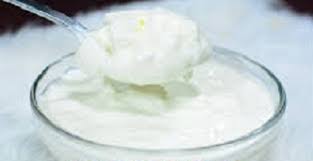
What is a Yoghurt?
Yoghurt also spelled Yogurt is a kind of dairy food produced from the bacterial fermentation of milk. Yoghurt culture is the name of bacteria used to make yoghurt. This yoghurt culture bacteria ferment lactose, the only natural sugar in milk. The process of this fermentation produces lactic acid which gives Yoghurt its characteristic sour taste. Because of this, yoghurt is easier to digest and gives much relief to people who are allergic to milk or lactose intolerant. Milk that is fermented tends to have a longer shelf life. Yoghurt has been enjoyed for centuries and regarded as one of the early health food, with ancient cultures using it as a way to preserve milk. Yogurt is among the healthy foods that boost the body’s immunity to diseases. You can read our Essential foods that boost the immune system.
Types of Yoghurt
There are many types of yogurt but we will only discuss some of the popular ones below.
Plain yoghurt
Plain Yoghurt is without any added colorant, flavoring, or sugar. It is a white thick liquid with a mild sour taste.
Greek yoghurt
Greek yoghurt is a popular type of yoghurt that is known to be creamy and thicker than regular yogurt. It is produced by straining the regular yogurt further in which the liquid whey is removed. What we then have is a yogurt that is creamier and thick. As a result, it has more protein content and less calcium.
Australian yoghurt
Australian yogurt is thick and creamy like Greek yogurt but the difference is that it is that honey is added to it as a sweetening agent, giving it a “sweet-tart tang” and “velvety texture.”
Frozen yoghurt
Frozen yoghurt is a dairy food that is often canvassed as a healthy alternative to ice cream. However, when you look at it very closely, it is just yoghurt put in the freezer. It is a popular dairy food made with yoghurt. Frozen yoghurt has some similarities with ice cream only that yoghurt is made with milk instead of cream.
Health benefits of Yoghurt
- Yoghurt aids in digestion and also gives relief to diarrhea and constipation patients. Yoghurt contains probiotics. Probiotics are live bacteria (good bacteria) that have been shown to lessen the uncomfortable symptoms of irritable bowel syndrome (IBS). Gut well-being is often neglected but its overall health plays an important role in our body’s absorption of vitamins and nutrients.
- Yoghurt is very rich in calcium. If you are concerned about the status of your bone condition, adding yogurt to your diet won’t be a bad idea. Yogurt will improve the density and also strengthen your bone. And if you already aging and may be at risk of osteoporosis, a glass of plain yogurt daily after lunch would do a lot of magic. Yoghurt can help men who want to build their muscles and develop burlier physiques. Yogurt, especially Greek yogurt, is a rich source of high-quality, muscle-building protein and it helps the body regain the loss of energy after rigorous training.
- Weight loss has been associated with consuming yogurt. A study that was conducted amongst people taking yogurt revealed that a change in weight is noticed when some unhealthy snacks are replaced by yogurt. It helps the fat in the belly to burn faster.
- Because of the high nutrients like zinc and vitamins, yogurt intake helps the body to fight diseases and infections. The live bacteria present in yogurt work on building our immunity and lowering our chances of contracting various illnesses.
- The good bacteria in yogurt may also help your vagina by balancing acid levels in your vaginal fluids. It helps restore the ideal PH level which promotes the growth of good bacteria over the bad ones. It is always advisable to choose yoghurt brands that contain live, active cultures such as Lactobacillus. Hollandia Yoghurt is a good example.
- Apart from helping in weight loss, Yoghurt drink can boost the sex drive in men and improve fertility. A cancer biologist Susan Erdman in partnership with Geneticist Eric Aim observed in their study that not only were there effects on weight loss when you take yogurt, but also on sex libido, fertility, and general wellbeing.
- Drinking plenty of yoghurt can also help in the treatment or prevention of vaginal odor. Vaginal infections like bacterial vaginosis can be cured by drinking lots of yoghurt. Yoghurt is also said to boost ovulation and improve fertility in women.
How to make yogurt step by step
First of all, making a yoghurt requires a simple step with few ingredients too. You won’t be needing special yogurt maker equipment. Making yoghurt is easier than most of us think. If you follow the below instructions, you will surely whip up a yoghurt of your dream.
Ingredients for making yoghurt
Yogurt ingredients list includes the following:
- Milk: Milk is the main ingredient on the list. The type of milk you will use will depend on the type of yogurt you want to make. Cow milk or whole milk is commonly used while skim milk is used for non-fat yogurt.
- Starter culture: The yoghurt starter culture, which is commercially known as DVS culture (direct vat-set) is the inoculum that is added to pasteurised milk in order for it to ferment and produce yoghurt. The main (starter) cultures in yogurt are Lactobacillus bulgaricus and Streptococcus thermophilus. The function of the starter cultures is to ferment natural sugar in milk to produce lactic acid. The increase in lactic acid decreases pH and causes the milk to coagulate giving rise to the tangy texture that is characteristic of yogurt. Lactobacillus bulgaricus and Streptococcus thermophilus are the only 2 cultures required by law to be present in yogurt.
Step 1
Heat the milk
Pasteurize the milk. You heat the milk to kill some germs as is often required by the federal health law. Heating the milk equally helps to break the milk protein which in turn results in a thick and creamy texture. You can achieve this heating in so many ways depending on the utensils available in your kitchen. You can heat it with a microwave. I prefer to use the microwave because you don’t have to worry about the milk boiling over to smear your kitchen utensils. It is also easy to steady its temperature in case you need to. You can also use the stove to heat your milk. However, using a stove entails that you turn the heat down to avoid scorching. The stove will also require that you stir frequently and monitor the temperature as you heat up.
No matter how you heat the milk, try not to make it boil. If it boils, it will not be smooth as desired. You can equally use an instant pot to heat and incubate the milk. The disadvantage I see here is that you may be restricted to only do a size the pot can contain. However, it is so convenient and the incubation is pretty easy.
Step 2
Cool the milk
Let the milk cool. The temperature of the milk needs to fall back to 100°F-115°F. The yogurt culture needs to come in when the milk has cooled down so that it won’t die off.
Step 3
Add the yoghurt starter
Stir the yogurt starter with the rest of the milk. A spoonful is adequate. This spreads the good bacteria throughout all the milk to achieve consistency.
Step 4
Incubate your milk
Cover your milk and incubate. Incubate the inoculated milk for 7 to 9 hours. At which every system is available to you, you should hold the temperature steady at 100°F – 115°F. This is the big moment. This is where it gets a little tricky. This is in fact the moment our milk transforms into yogurt.
If our milk gets too hot at this stage, it will kill the starter bacteria hence no yoghurt. On the other hand, if the milk could stay warm or lukewarm enough, the bacteria won’t react and eat the lactose to produce lactic acid. One can ask, ” What is the best way to incubate yoghurt?”
Well, the answer depends on what you have in your kitchen. If you have an oven, you can set it on the ‘dehydrate’ or ‘bread proof’ setting. You can also achieve a steady warm temperature when you heat up your oven for a few minutes and then turn it off. You can then wrap the warm milk in a blanket and set it inside the oven. If you are using an instant pot, use the setting there to incubate. You can equally search for a warm place in your house and place it there.
It is good to note here that the longer you incubate, the more tart your yoghurt will be.
Step 5
Remove yogurt from incubation and freeze (if you want a frozen yoghurt) or strain further if you are making a greek yoghurt. You can chill the plain yogurt for 2-3 hours and then serve. You can use cheesecloth to strain your yoghurt though there are other ways. Other ways to strain a plain yoghurt include methods with coffee filters, a fine-mesh sieve, or a yogurt pouch.
FAQ about making yogurt
Culturing time is an essential factor in making good yogurt. The amount of time the yogurt cultures depends on your taste and texture preference. The longer yogurt cultures, the more tart and thick it will become. It also depends on the yoghurt’s temperature and the culture used. You can allow it for 5 hours and/or up-to overnight.
The difference between curd and yoghurt is very thing. This is because both are dairy products made through somewhat similar methods. In yoghurt, bacteria are added to ferment the milk, producing lactic acid which gives yoghurt its characteristics and tangy taste. Curd, however, is made by adding acidic substances like lemon juice, vinegar, or rennet to the milk which results in coagulation or curdling.
Another difference between yoghurt and curds is that the curds can often be further processed to make cheese.
Yes. Yogurt is highly recommended for pregnant women. Yogurt is a good source of calcium, which is necessary for the development of your baby’s bones and teeth, as well as heart, nerve, and muscle function. If you don’t consume enough calcium, your body will take it from your bones. They help you meet increased protein and calcium needs.
Heating and cooling the milk would probably take 2-3 hours. The incubation period would normally last 6-10 hours while straining will take up to 3 hours depending on the style and method. Adding up all these hours seems like an all-day affair but the actual hands-on is around 20 minutes. Other times are hands off the work.
The purpose of heating the milk is not only to kill off any microorganisms that may have found their way into the milk. That leads us to the single most important thing (heating) scalding does: It denatures the whey protein lactoglobulin. In other words, it is done in order to unravel the proteins so that the product will be a thicker yogurt.
A tablespoon of yoghurt starter per quart of milk is ideal. Yogurt bacteria are big eaters and don’t like to be crowded. More quantities aren’t necessary.

